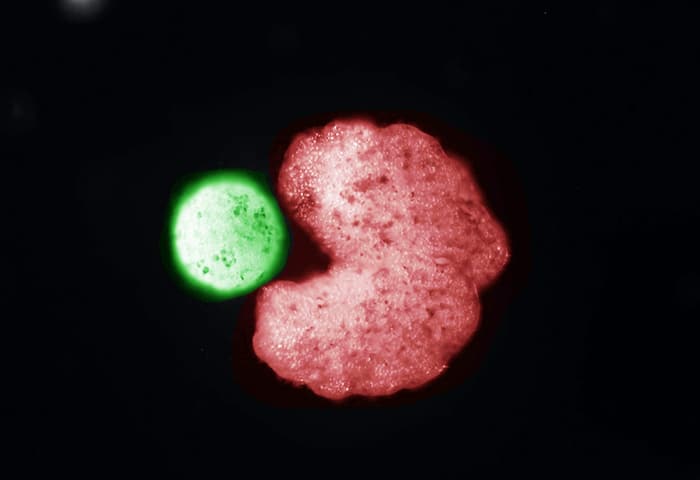Photo: A mature xenobot (red) gathers its own kind (green). / © Douglas Blackiston and Sam Kriegman
AI-engineered and hand-built xenobots – living machines made from frog embryonic cells – can now spontaneously reproduce themselves.
Biology The first xenobots were presented by a group of American scientists in 2020. To create them, stem cells were used, obtained from the embryos of the South African frog Xenopus laevis (hence the name of the robots). The frog’s genome remained unchanged, but the cells were reprogrammed to make skin cells in the embryo, but the researchers gave them a chance to rethink their purpose. After incubation, about 3000 cells were connected by hand using tiny tweezers and an even tinier electrode. Xenobots created in this way could move in space, find specified targets and recover from damage.
In the new work, scientists have endowed xenobots with another attribute of the living, showing that they can create their own kind. In fact, this is a completely new way of reproduction: “adult” xenobots collect individual cells, holding them together, and after a few days the collected “babies” turn into full-scale xenobots. Xenobots use what is known as kinematic self-replication, a process previously observed only at the molecular level.
Video about a new kind of xenobots here – (As Pac-man-shaped Xenobot “parents” move around their environment, they collect loose stem cells in their “mouths” that, over time, aggregate to create “offspring” Xenobots that develop to look just like their creators. Credit: Doug Blackiston and Sam Kriegman)
To figure out which form of xenobots is best for reproduction, scientists turned to artificial intelligence. An evolutionary algorithm running on a supercomputer tested billions of xenobots’ body shapes – triangles, squares, pyramids, stars – and found the one that would provide the most efficient kinematic self-replication. This task took the supercomputer several months, and as a result, it settled on a C-shape, reminiscent of the “Pacman” from the game of the same name. Then the scientists assembled robots according to the scheme proposed by the computer and showed that new xenobots can successfully reproduce themselves for several generations.
The authors of the work believe that the results of their research can have both theoretical and practical results: on the one hand, using xenobots, one can better understand the reproduction process itself, and on the other, create living machines for regenerative medicine, the development of new drugs, or even the collection of microplastics. in water.
An article with the results of the research was published in the journal Proceedings of the National Academy of Sciences.









